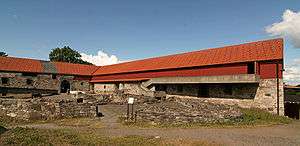Alv Knutsson
Alv Knutsson (c. 1420–1496) was a Norwegian nobleman who descended on his father’s side from the influential and wealthy Swedish Tre Rosor noble family. He was a member of the Norwegian council of the realm and also served as commander of the royal castle in Bergen.[1] [2]

Landholdings
Alv Knutsson held over 276 farms in east and south Norway. He held important Norwegian fiefs including Solør and was one of the largest property holders in Norway inheriting part of the knight and Norwegian National Councilor Sigurd Jonsson’s vast properties, including the Sørum estate (Sudreim) in Romerike and Giske estate in Sunnmøre. His wife Magnhild Oddsdatter (ca. 1425–1499) from Finne in Voss was the widow of Bengt Harniktsson who died ca. 1446. Through his marriage, Alv Knutsson also held Grefsheim in Hedmark.[3][4][1]
Feud between the Krummedige and the Tre Rosor families
Upon the 1448 death of King Christopher of Bavaria, who was union king of Denmark (1440-1448), Sweden (1441-1448) and Norway (1442-1448), the Norwegian succession resulted in controversy. In Norway the new king had to be elected by the Norwegian National Council. There were effectively two parties in the Norwegian National Council: The pro-Danish party led by Hartvig Krummedige (then the commandant at Akershus Fortress) and Bishop Jens of Oslo, and the pro-Swedish party led by the Archbishop Alsak Bolt and Erik Saemundsson (then the commandant at Tønsberg Fortress). [5][6][7]
The pro-Danish party prevailed and Christian I of Denmark was elected king, although not without subsequent strife. Karl Knutsson invaded from Sweden and proceeded to Hamar, where he called a thing, and was “elected king” by Archbishop Bolt, Erik Saemundsson and others who assembled there. King Karl proceeded to Trøndelag. He then returned to Sweden, leaving Saemundsson as viceroy. Saemundsson invested Akershus fortress, which was held by Krummedige, who still adhered to Christian I. Ultimately Saemundsson was killed by Krummedige, the leading pro-Swedish advocates fled to Sweden, and Karl Knutsson renounced his claim to the throne. Saemundsson and Alv Knutsson were members of the Tre Rosor family, which title comes from their coat of arms, which includes three roses.[8]

Swedish forces again invaded Trøndelag in 1453, but were repelled and were forced to turn south across the Dovrefjell and to Hamar, where they captured and occupied the Hamar Bishop’s palace (Hamarhus). Hartvig Krummedige proceeded north, expelled the Swedish forces, and killed many of them, including further relatives of Knut Alvson. With this act, as well as his previous involvement in the death of Saemundsson, Krummerige earned the lasting enmity of pro-Swedish Alv Knutsson. Alv Knutsson had extensive holdings, was highly influential and could bring substantial pressure to bear. He arranged that charges be brought against Hartvig Krummedige by one of the local farmers – as a result Hartvig Krummedige lost all of his fiefs. Knutsson also worked through the Pope to obtain a Papal Bull concerning Krummedige’s misuse of power. In spite of this dramatic setback, Christian I of Denmark restored Krummedige to Akershus by 1461. Hartvig Krummedige died in 1476, but his son Henrich Krummedige remained a firm member of the pro-Danish party — the rivalry with the Tre Rosor family virtually guaranteed this would be so.[8]
Alv's son Knut Alvsson subsequently led an unsuccessful attempt to gain the crown of Norway. In 1500 King Hans of Denmark, Sweden and Norway made an ill-fated attempt to conquer the Ditmarshes (Dithmarschen) in Northern Germany. Knut Alvsson, who had married the granddaughter of Karl Knutsson, and was involved with the Swedish Independence Party, concluded it was time to act. His rebellion began in 1501 in Sweden, but soon came to Båhus Fortress in Norway on the Swedish-Norwegian border, which Henrich Krummedige commanded. Krummedige held his fief at Båhus, but Alvsson captured Akershus Fortress in March 1502, although the citizens of Oslo remained pro-Danish while the nobles and bishops of the country remained neutral—presumably waiting to see which side prevailed.[8][9]
King Hans dispatched his son Christian (later crowned King Christian II of Denmark) at the head of forces; they relieved the siege of Båhus Fortress, and then captured and reduced Älvsborg Fortress across the river from Båhus Fortress in Gothenburg, Sweden. Krummedige then led forces north to finish off the rebellion by recapturing Tønsberg Fortress and invested Akershus Fortress, which Alvsson was defending.[8]
When it became clear that the rebellion had failed, Alvsson came on board one of Krummedige's ships under a safe conduct. Krummedige killed Knut Alvsson, either by treachery or, as alleged, in response to Alvsson's own violence. Alvsson was judged a traitor and Alvsson's property was forfeit to the crown. Krummedige had prevailed, although Gjerset reports he was compelled to leave Norway and the uprising was not totally quelled until 1504. This ended the male Tre Rosor line in Norway.[8][9]
References and notes
- 1 2 Henriksen, Petter, ed. (2009). "Alv Knutsson". Store norske leksikon (in Norwegian). Oslo: Kunnskapsforlaget. Retrieved 23 April 2009.
- ↑ Jon Gunnar Arntzen. "Tre Rosor". Store norske leksikon. Retrieved June 1, 2017.
- ↑ Per-Øivind Sandberg. "Magnhild Oddsdatter". Norsk biografisk leksikon. Retrieved June 1, 2017.
- ↑ Jon Gunnar Arntzen. "Grefsheim". Store norske leksikon. Retrieved June 1, 2017.
- ↑ Ole Jørgen Benedictow. "Hartvig Krummedike". Norsk biografisk leksikon. Retrieved June 1, 2017.
- ↑ Per-Øivind Sandberg. "Erik Sæmundsson". Norsk biografisk leksikon. Retrieved June 1, 2017.
- ↑ Audun Dybdahl. "Aslak Harniktsson Bolt". Norsk biografisk leksikon. Retrieved June 1, 2017.
- 1 2 3 4 5 Stagg, Frank Noel (1956). East Norway and its Frontier. George Allen & Unwin, Ltd. pp. 81–83. Retrieved 19 April 2009.
- 1 2 Gjerset, Knut (1915). History of the Norwegian People Volume II. The MacMillan Company. pp. 83–84. Retrieved 18 April 2009.